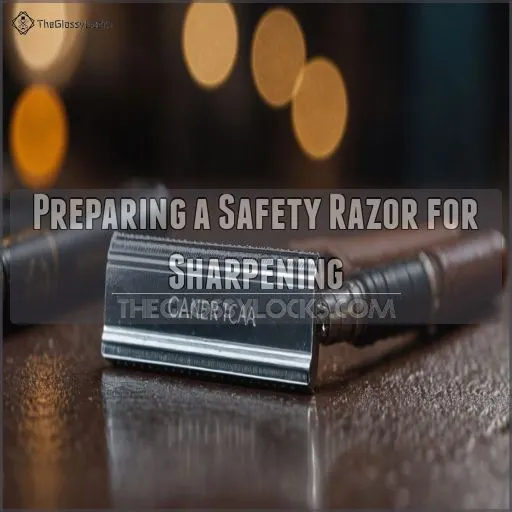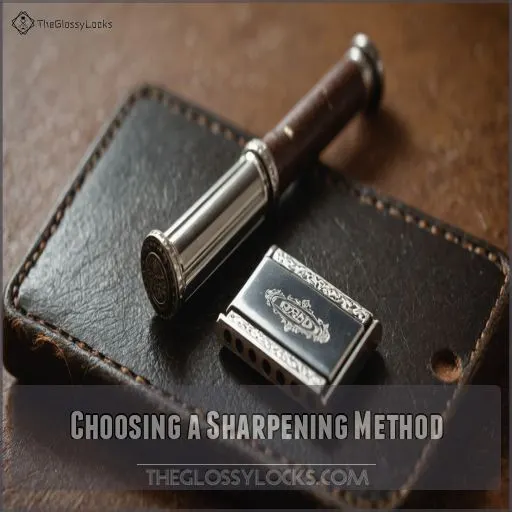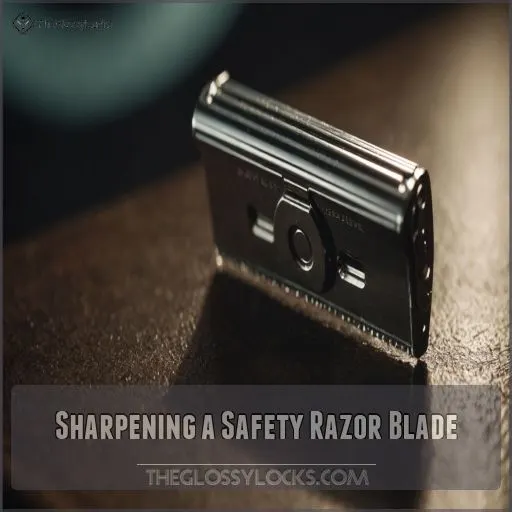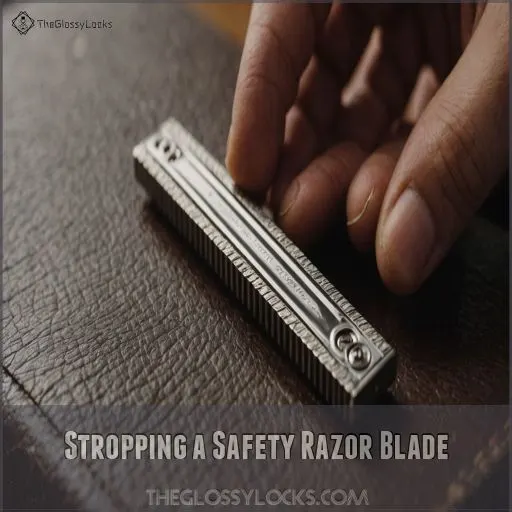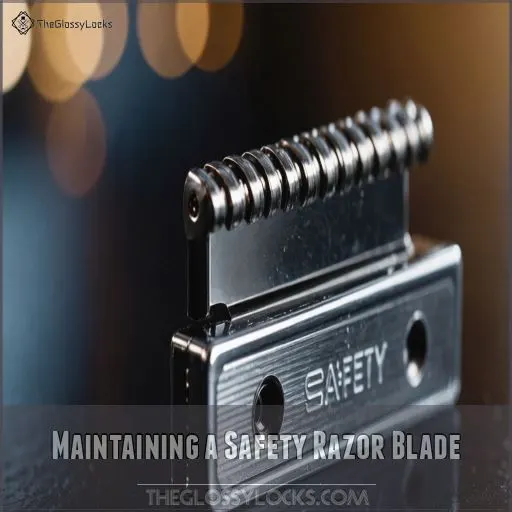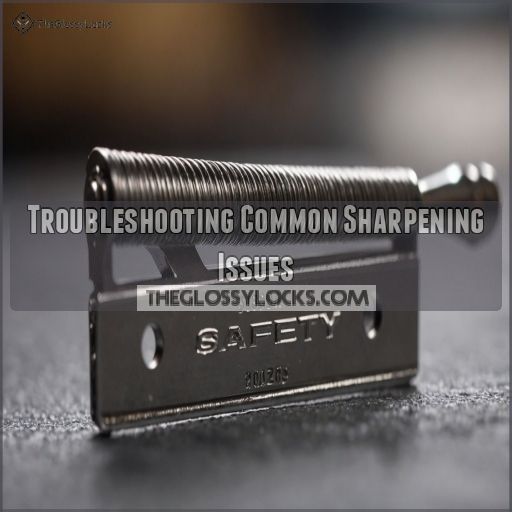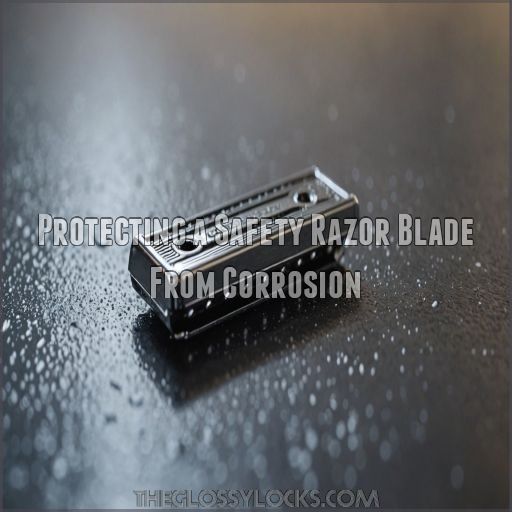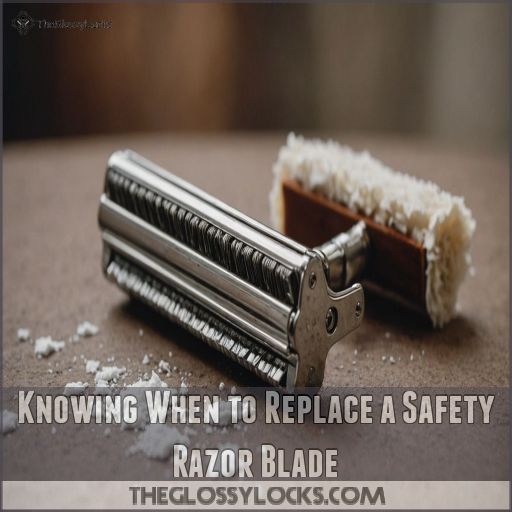This site is supported by our readers. We may earn a commission, at no cost to you, if you purchase through links.
 Sharpening a safety razor can be a breeze!
Sharpening a safety razor can be a breeze!
First, give your blade a nice soak in warm, soapy water to loosen any gunk, then dry it off completely.
Now for the fun part—angle the blade at about 30 degrees on a sharpening stone or a honing pad. Use gentle, steady pressure as you guide it along the surface. You might even try stropping on denim or canvas for a polished edge.
Remember, patience and a light touch are your best friends here.
Ready to dive deeper into advanced techniques? Discover more effective ways to keep your razor sharp and smooth.
Table Of Contents
- Key Takeaways
- Preparing a Safety Razor for Sharpening
- Choosing a Sharpening Method
- Sharpening a Safety Razor Blade
- Stropping a Safety Razor Blade
- Maintaining a Safety Razor Blade
- Troubleshooting Common Sharpening Issues
- Protecting a Safety Razor Blade From Corrosion
- Knowing When to Replace a Safety Razor Blade
- Frequently Asked Questions (FAQs)
- Can a safety razor blade be sharpened?
- How to sharpen razors at home?
- How to keep safety razor blades sharp?
- How to sharpen a razor without a sharpener?
- What materials should be avoided for sharpening?
- Can a safety razor be used daily?
- How often should a razor be sharpened?
- Is there a special technique for double-bladed razors?
- Are there eco-friendly sharpening options?
- Conclusion
Key Takeaways
- Sharpen your safety razor like a pro by using a sharpening stone, honing strop, or even your trusty old jeans — just remember to keep that angle consistent and the pressure light as a feather.
- Proper blade maintenance is key — clean off any gunk, dry it thoroughly, and give it a protective coating to keep rust at bay. Your razor will thank you with a smoother, longer-lasting shave.
- Don’t be afraid to experiment with different sharpening methods — from ceramic mugs to canvas strops, there are plenty of DIY tricks to try. Just be patient and embrace the journey to that razor-sharp edge.
- Know when it’s time to swap out that tired old blade. If you’re dealing with tugging, uneven shaves, or increased irritation, it’s time for a fresh start. Regularly changing blades keeps your shave smooth and your wallet happy.
Preparing a Safety Razor for Sharpening
Sharpening your safety razor starts with a squeaky-clean blade—because who likes shaving with leftover grime?
Give your blade a bath, dry it thoroughly, and kick out any mineral deposits to get it ready for that sharp edge you’ve been dreaming about.
Cleaning the Razor Blade
Before sharpening your safety razor blades, let’s clear off any rust and grime first!
Grab some cleaning tools and start by soaking the blades briefly in warm, soapy water—just enough time to loosen debris.
Use a small brush to gently scrub away any stubborn bits.
Remember, blade maintenance extends blade life and sharpens with ease by following these cleaning techniques.
Drying the Razor Blade
Drying your safety razor blade is like giving your trusty steed a well-deserved rest after a long journey, and proper storage is key.
After you’ve given it a rinse, grab a lint-free cloth or towel and gently pat it down.
Air dry the blade to prevent rust, keeping it sharp and ready for action.
Consistently doing this helps maintain your blade’s sharpness, well, razor-sharp! .
Removing Debris and Mineral Deposits
The white mineral deposits on your razor don’t stand a chance against a few simple tricks.
First, soak the blade in hot water with a drop of dish soap for 5 minutes.
Then, gently scrub with a soft toothbrush.
For tougher buildup, try a quick dip in rubbing alcohol followed by a cotton ball wipe-down.
Choosing a Sharpening Method
When you’re ready to sharpen your safety razor, picking the right method is key to achieving that perfect edge.
There’s an option that’ll suit your style and keep your shave smooth.
Whether you fancy stones, strops, or even your old jeans.
Using a Sharpening Stone
Embrace your inner blade whisperer! Grab a sharpening stone—it’s your trusty sidekick.
Hold your safety razor at a 30-degree angle; let it lightly sing across the surface. Repeat with gentle pressure.
Choose stones wisely: coarse for reshaping, fine for precision. Keep them clean and dry for peak performance. It’s blade-maintaining magic in your hands!
| Stone Types | Pros |
|---|---|
| Coarse Stones | Reshape blades quickly |
| Fine Stones | Offer precise sharpening |
| Natural Stones | Eco-friendly and durable |
| Synthetic Stones | Uniform grit and affordable |
Using a Honing Strop
Engage your honing strop to sharpen safety razor blades by laying the blade flat with the edge toward you.
Lightly draw it across leather, denim, or canvas without applying pressure.
Keep the angle consistent—like balancing on a tightrope! This prevents uneven sharpening.
With patience, a double edge razor blade will feel safety-razor-blade sharp again.
Using a Razor Blade Sharpening Kit
Got a dull blade? A razor blade sharpening kit can save the day!
Align your safety razor at a 35-degree angle on the honing pad, then push it upwards in a sweeping motion.
Practice makes perfect. You’ll soon master this technique, adding precision and longevity to your shave, while saving a bit of cash and embracing sustainability .
Using Denim or Canvas as a Strop
To sharpen your safety razor blade using denim or canvas, follow these steps for effective maintenance:
- Set Up: Lay denim flat on a hard surface.
- Position the Razor: Glide the blade opposite to shaving.
- Stroke Count: Do 10-20 swipes.
- Pressure Control: Apply light pressure; too much can damage blades.
Remember, proper blade care and storage enhance longevity.
Sharpening a Safety Razor Blade
Sharpening a safety razor blade can feel like trying to slice a tomato with a butter knife, but it’s easier than you think!
Whether you’re using a sharpening stone, razor blade kit, or even denim, these simple techniques will help you achieve a close shave without the frustration of a dull blade.
Method 1 – Using a Sharpening Stone
Grab your trusty sharpening stone and get ready to revive that dull safety razor blade!
Start by angling the razor at around 35 degrees and gently push it up the stone, lifting it back down without dragging.
Repeat this 5 times on each side to realign that edge.
Just be sure to keep a light, consistent pressure – no need to grind away the metal.
Method 2 – Using a Honing Strop
Embrace the art of using a honing strop to maintain your blade’s edge!
Follow these steps:
- Choose the strop type: Leather’s classic, denim’s bold.
- Mind the angle: Keep it shallow; pretend you’re slicing butter.
- Watch the pressure: Just a feather touch—too hard and you’ll dull rather than sharpen.
Happy stropping!
Method 3 – Using a Razor Blade Sharpening Kit
If you’re tired of honing strops, a razor blade sharpening kit might be your new best friend.
These kits simplify sharpening by providing a leather honing pad.
Here’s the scoop: tilt your safety razor to a 35-degree angle, glide it up the pad, lift, and repeat.
With regular use, these kits triple blade life, saving you time and cash (Source).
Alternative Methods for Sharpening a Safety Razor
You’ve explored sharpening kits, how about a DIY twist?
- Try denim stropping: Grab some old jeans and run the razor back and forth for a fresh edge.
- Or canvas stropping: Hang a strip and start stropping.
- Use everyday tools like a kitchen ceramic mug’s unglazed bottom—perfect for maintaining the blade angle.
Happy sharpening! .
Stropping a Safety Razor Blade
Sharpen your safety razor blade by stropping, a method that’s both efficient and surprisingly simple.
Stropping can be done with leather, denim, or canvas.
Mastering this technique can make shaving feel smoother than your first attempt at a social media dance challenge.
Using a Leather Strop
If you’re looking to sharpen your techniques, leather strops are your trusty sidekick.
Think of them as your razor’s best pal, aligning those tiny edge imperfections.
It’s a bit like ironing a wrinkled shirt after a night out.
| Strop Type | Maintenance Tips | Care Essentials |
|---|---|---|
| Hard Leather | Light conditioning | Regular cleaning |
| Soft Leather | Minimal pressure | Occasional oiling |
| Mounted Strop | Secure storage | Avoid excess moisture |
Strop wisely and enjoy smoother shaves!
Using a Denim Strop
Switching from leather to denim, use a pair of old jeans to strop your safety razor blade.
Hold the denim taut and run the blade along it, edge first, with about 20 strokes per side.
Denim’s rough texture helps align the blade, extending its life and shave quality.
It’s a fun trick that won’t cost you a dime!
Using a Canvas Strop
Moving from the denim strop, a canvas strop offers a unique advantage – it helps warm and align the razor’s delicate edge.
Simply run the blade across the canvas in long, even strokes.
The canvas’s texture gently cleans and preps the edge, preparing it for the final polish on the leather strop.
- Use a high-quality canvas strop, either linen or cotton, for best results.
- Strop the razor on the canvas after each shave to remove any residual moisture.
- Maintain the canvas strop by keeping it clean and free of debris.
Stropping Techniques for a Sharp Edge
Imagine this: you’re stropping your safety razor blade like a maestro tuning a violin.
Use a leather or denim strop, and focus on the right angle and gentle pressure.
Glide the blade with smooth strokes, about 15-20 per side.
It’s less about brute force, more about finesse—like convincing a cat to take a bath .
Maintaining a Safety Razor Blade
Keeping a safety razor blade in good shape means you’ll get a smooth shave and save some cash by following proper drying and storage techniques.
Keep your razor sharp and rust-free by storing it properly, cleaning it regularly, and giving it some TLC with the occasional stropping—think of it as a spa day for your razor!
Proper Storage of Razor Blades
Now that your blade is sharp, let’s chat about storage.
Keep blades in a dry spot to dodge rust.
Try a case to limit air exposure—dust is sneaky!
Oil’s your buddy; a thin coat after shaving prevents rust and keeps things smooth. It’s like a spa day for your razor!
Trust these blade storage tips to prolong lifespan for your razor.
Cleaning and Drying After Use
Keeping your safety razor clean and dry after each use helps it stay in tip-top shape and avoids pesky rust.
After storage, rinse it well, shake off excess water, and gently towel-dry.
- Rinse under warm water to remove soap buildup .
- Dab with a clean towel to prevent water spots.
- Store in a dry, ventilated spot .
Regular Honing and Stropping for Maintenance
After cleaning, honing, and stropping are your trusty sidekicks.
Honing refines; stropping aligns.
Multiply shaves with these stropping techniques.
Use materials like leather, denim, or even old canvas pants; they’re edge saviors!
Here’s a quick guide:
| Task | Material | Frequency |
|---|---|---|
| Honing | Stone | Monthly |
| Stropping | Leather | Weekly |
| Blade Check | Visual | Biweekly |
Keep your blade sharp and aligned! .
Inspecting the Blade for Damage
Regular honing keeps your razor sharp, but it’s smart to check for damage too.
Look for blade nicks, edge wear, rust spots, blade chips, or bent blades—telltale signs your blade’s on its last leg.
If your razor seems nastier than a slice of day-old pizza, it’s time to swap it out and enjoy smooth shaves again .
Troubleshooting Common Sharpening Issues
Sharpening a safety razor can sometimes feel like a science experiment gone wrong, but don’t worry—you’re not alone!
Whether it’s uneven edges or mysterious nicks, we’ll help you troubleshoot these sharpening mysteries and get your razor back to delivering that smooth shave you love.
Uneven Sharpening
Feeling like your safety razor has a mind of its own? Uneven sharpening can drive you batty! Aim for Blade Alignment with steady, consistent strokes. Mind your Sharpening Angle to keep things sharp. Stropping Pressure matters too, so don’t get heavy-handed.
- Check Blade Condition regularly.
- Use quality Strop materials.
- Practice makes perfect—embrace the journey!
Damaged or Worn-Out Blades
A few signs that your safety razor blade’s worn out include dullness, rusting, or pulling rather than gliding smoothly—it’s like trying to mow the lawn with a spoon.
Recognize these indicators not just with your eyes.
Regular replacement matters, as even skilled sharpening can’t revive every blade.
Here’s a quick table for clarity:
| Signs | Impact | Solution |
|---|---|---|
| Dullness | Tugging | Sharpen/Replace |
| Rusting | Corrosion | Dispose of |
| Pulling | Irritation | Replace |
Nicks and Chips on the Blade
Blade damage? It’s not the end of the world! Nicks and chips can be honed out on a stone—a skill worth mastering.
Avoid "sink bite" by closing the razor when rinsing, and keep that edge away from countertops!
Stropping after each shave helps extend blade life, while preventing further damage or chip repair needs.
Resolving Common Sharpening Problems
Handling pesky nicks or uneven sharpening can feel like taming a wild beast! Focus on these steps to restore harmony:
- Assess the blade for worn-out spots or nicks.
- Use a honing strop to smooth out imperfections.
- Sharpen on a stone, balancing pressure on both sides.
- Strop with denim for a final check .
Happy shaving!
Protecting a Safety Razor Blade From Corrosion
Keep your safety razor blade from rusting with a little TLC and proper storage!
Coat it with mineral oil and store it somewhere dry,
and it won’t turn your bathroom into a chemistry experiment gone wrong.
Using Mineral Oil or Cooking Oil
Mineral oil is a fantastic way to protect your safety razor blade from rust.
Just give the blade a quick dip after stropping, let the excess evaporate, and store it in a dry area.
This light, skin-safe oil displaces water and keeps your blade in tip-top shape.
No more worrying about unsightly rust spots!
| Oil Type | Benefits |
|---|---|
| Mineral Oil | Skin-safe, low viscosity, displaces water |
| Camellia Oil | Excellent all-around razor oil, easy to apply |
| Petroleum Jelly | Works well for protecting tools, including razors |
Applying a Protective Coating
After protecting your razor blade with mineral oil, consider applying a protective coating.
You’ve got options: PTFE or chromium coatings are popular for lower friction and resistance to oxidation .
Just like sunscreen, they act as a shield against the elements, keeping your blade sharp and corrosion-free.
Remember that the application process can be a bit tricky, so patience pays off!
Storing the Razor in a Dry Environment
To keep your safety razor blade rust-free, stash it away from moisture.
A dry spot, like a bathroom cabinet, works wonders.
Humidity is the arch-nemesis here, so guard your razor like it’s a prized possession.
Consider using a dedicated case for extra protection—think of it as your blade’s personal VIP lounge.
Keep it dry, keep it sharp, keep it smiling .
Avoiding Corrosion With Regular Maintenance
Keeping your razor blade rust-free is like safeguarding a treasured recipe—simple measures make all the difference.
After use, apply a thin coat of oil like a protective sweater to guarded it.
Store it in a dry spot, far from rainshowers, and [citation:1;2;3].
Knowing When to Replace a Safety Razor Blade
Ever feel like your razor is cutting more like a butter knife than a blade?
If your shave‘s become rougher than your Monday morning, it might be time to swap out that tired blade for a sharp new one.
Signs of a Dull Blade
After protecting your blade from corrosion, watch for signs of dullness. You might feel shaving irritation or notice these telltale hints:
- Pulling hair: If your razor acts like it’s tugging weeds, it’s time for a change.
- Uneven shave: Patchy results mean the blade’s calling it quits.
- Reduced lather effectiveness: When blades aren’t cutting it, lather becomes futile.
Frequency of Use and Blade Life
Discover the secret to razor longevity: shaving frequency and blade maintenance.
If you shave daily, you might change blades every week.
Use quality shaving cream to reduce wear and extend blade sharpness.
Don’t forget—proper blade storage is key to fighting corrosion.
So treat your razor like a treasured ally; it’ll repay you with smoother shaves!
Assessing the Condition of the Blade
You’ve been shaving with that same blade for a while, but how can you tell when it’s time to swap it out?
Look for a few telltale signs – if the blade starts tugging at your hair instead of slicing through cleanly, or if you notice uneven patches or increased irritation, it’s likely time for a fresh edge.
- Tugging or pulling sensation
- Uneven or patchy shave
- More passes required for a clean shave
- Increased razor burn or irritation
- Dull, worn appearance of the blade
Replacing the Blade for Optimal Performance
Hey there, don’t wait for your razor to become a hacksaw! Keep an eye on blade life.
When irritation strikes or you’re tugging more than shaving, it’s time for a swap.
Regularly changing blades minimizes irritation, saves costs, and reduces environmental impact.
Remember, a happy shave means a happier you, and sometimes a fresh blade speaks louder than a honed word.
Frequently Asked Questions (FAQs)
Can a safety razor blade be sharpened?
In the spirit of old-timey barbers, you can strop safety razor blades to realign their edges, but don’t expect miracles—modern blades with coatings lose sharpness quickly after stropping.
It’s often not worth the hassle.
How to sharpen razors at home?
Sharpening razors at home is easy!
Simply swipe the blade on old jeans 15-20 times, using confident strokes.
Clean, dry, and oil the blade to maintain sharpness.
It’s quick and gives your razor a new lease on life! .
How to keep safety razor blades sharp?
You’re worried about keeping your safety razor sharp?
After each shave, rinse and dry it thoroughly.
Strop the blade on denim or leather.
Store it dry, possibly in alcohol, to fend off rust .
How to sharpen a razor without a sharpener?
Don’t have a sharpener? No problem!
Use sandpaper, a leather belt, or even a nail file to hone that razor to a razor-sharp edge.
Just maintain a consistent angle and apply light pressure for a smooth, clean shave.
What materials should be avoided for sharpening?
Steer clear of sharpening your razor with anything but leather and smooth surfaces.
Sandpaper and harsh materials can chew up the blade like a dog with a new toy, leaving you with nicks and frustration instead of precision (Source).
Can a safety razor be used daily?
Yes, you can use a safety razor daily if your technique is good and you use the right gear.
You can master the art of the daily shave by starting slow and keeping your skin care on point.
How often should a razor be sharpened?
Think of changing blades as a sign of a sharp shave.
Swap them every 5-10 shaves for the best comfort.
If it tugs or irritates, it’s time for a new one; that’s your gentle nudge .
Is there a special technique for double-bladed razors?
For double-bladed razors, maintain sharpness by cleaning and drying after use.
Strop gently on a leather strip, applying steady pressure.
Flip and strop again for polished edges, ensuring a smooth shave like slicing through melted butter (Source).
Are there eco-friendly sharpening options?
Glide the blade smoothly, maintaining a consistent angle.
You’ll extend its life while being gentle on the planet .
Conclusion
When you master sharpening a safety razor, you’ll glide through your morning shave like a hot knife through butter!
With techniques like using a honing pad or even stropping on denim, you’re the craftsman of your grooming routine.
These methods not only extend your blade’s life, but they also save you money and reduce waste—it’s a win-win!
So, embrace these easy techniques to keep your safety razor sharp and ready to tackle each new day.

